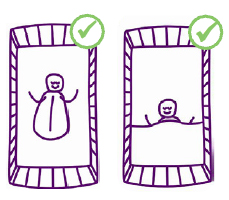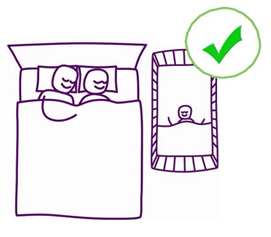Safe infant sleeping
Six ways to sleep your baby safely and reduce the risk of sudden unexpected death in infancy (SUDI)
- Keep baby on back.*
- Keep baby’s head and face uncovered.
- Keep baby smoke free before and after birth.
- Provide a safe sleeping environment night and day.
- Sleep baby in a safe cot in your room.
- Breastfeed baby.*
Please note:
* Medical advice may be needed for babies with a severe disability.
** While breastfeeding is best, it may not be possible for every mother.
To sleep your baby safely, follow this advice wherever your baby sleeps, including at the home of friends or relatives.

Room-sharing is recommended
Room-sharing is when your baby sleeps in their own cot next to your bed. This is recommended for the first 6 to 12 months of your baby’s life.
This can help you to:
- respond quickly to your baby’s needs
- settle and comfort your baby more conveniently than if sleeping in a separate room
- bond with your baby
- maintain breastfeeding
- reduce the risk of your baby dying from SUDI, including Sudden Infant Death Syndrome (SIDS) or fatal sleep accidents.

Safety tips for cot sleeping
Where to place your baby
It’s important to place your baby in the cot with their feet close to the bottom end.
Bedding or covers
You should use a baby sleeping bag with fitted neck and arm holes or lightweight bed covers (not a doona). If you use the lightweight bed covers, tuck them in firmly and make sure they only come up to your baby’s chest.
Mattress, cot and bassinette
The mattress should be firm, flat and fit the cot/bassinette without any gaps around the edges.
Make sure your baby’s cot meets the Australian cot standards (external site), as some older second hand cots may not.
There should be no large gaps between the bars of the cot. Large gaps could trap your baby’s head.
Wrapping and clothing
Wrapping your baby may help them to settle and stay on their back.
The wrap should be loose enough to allow your baby’s hips to bend and chest to expand.
Do not wrap your baby when they are unwell.
To stop your baby from overheating, do not over dress your baby and keep their head uncovered (no beanies).
Safe sleeping environment
Your baby should not be left to sleep unsupervised in a pram, stroller or bouncinette.
You should be aware that items placed in your baby’s cot may cause suffocation and reduce airflow.
Do not place these items in your baby’s cot:
- soft toys
- cot bumpers
- sleep positioning aids
- sheepskin rugs
- woollen underlays.
Where to get help
- Visit your midwife or child health nurse.
- See your doctor.
- Ring healthdirect Australia on 1800 022 222.
Ngala Parenting Line
- 8.00am – 8.00pm 7 days a week
- Phone: 9368 9368
- Outside metro area – Free call 1800 111 546 (free from land line only).
Remember
- Sharing a room with your baby is recommended for the first 6 to 12 months.
- Never leave your baby sleeping unsupervised in a pram, stroller or bouncinette.
Acknowledgements
Women and Newborn Health Service (WNHS)
This publication is provided for education and information purposes only. It is not a substitute for professional medical care. Information about a therapy, service, product or treatment does not imply endorsement and is not intended to replace advice from your healthcare professional. Readers should note that over time currency and completeness of the information may change. All users should seek advice from a qualified healthcare professional for a diagnosis and answers to their medical questions.